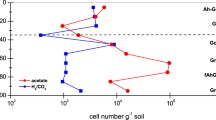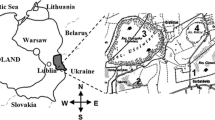Abstract
Laboratory experiments were conducted to study the variation of CH4 oxidation patterns in flooded rice soil profiles. The results indicated that surface soil presented the strongest CH4 oxidation activities as shown by the highest values of the two kinetic parameters of CH4 oxidation, Vmax and Km in the ecosystem without rice plants. Vmax and Km decreased significantly from top to bottom in the paddy rice soil profile, ranging from 12.5 to 1.2 µg h-1 g-1 and 165 to 4.1 µg g-1, respectively. In addition, we studied the effect of headspace N2, O2 and their ratio on CH4 emission and oxidation to provide information on the sensitivity of methanogens and methanotrophs to soil redox change resulted from gas transportation through arenchyma. Methane emission rate increased, however, CH4 oxidation rate decreased with a decrease of O2 concentration in the headspace. Headspace H2 increased CH4 emission rate substantially. In addition to H2 being a substrate for CH4 formation, the change of soil redox potential to a considerably low level H2 should also contribute to the increase in CH4 emission.
Similar content being viewed by others
References
Barker HA (1956) Bacterial fermentations. Wiley, New York, USA. p 1–95
Bender M & Conrad R (1992) Kinetics of CH4 oxidation in oxic soils, exposed to ambient air or high CH4 mixing ratios. FEMS Microbiology Ecology. Elsevier Science Publishers, Amsterdam, Oct 1, 1992. v. 101(4): 261–270.
Chanton JP, Martens CS, Kelley CA, Crill PM & Showers WJ (1992) Mechanisms of methane transport and isotope fractionation in macrophytes of Alaskan tundra lakes. J Geophys Res 97: 16681–16688
Cleland WW (1979) Statistical analysis of enzyme kinetic data. Meth Enzymol 63: 103–183
Conrad R & Rothfuss F (1991) Methane oxidation in the soil surface layer of a floded rice field and the effect of ammonium. Bio Fert Soil 12: 28–32
Cornish-Bowden A (1979) Fundamentals of Enzyme Kinetics. Butterworth, Boston, USA
De Bont JAM & Mulder EG (1974) Nitrogen fixation and co-oxidation of ethylene by a methane utilizing bacterium. J Gen Microbiol 83: 113–121
Flessa H and WR Fischer (1992) Plant-induced changes in the redox potential of rice rhizosphere. Plant and Soil 143: 55–60
Frenzel P, Rothfuss F & Conrad R (1992) Oxygen profiles and methane turnover in a flooded rice microcosm. Biol Fert Soils 14: 84–89
Hanson RS (1980) Ecology and diversity of methylotrophic organisms. Adv Appl Microbiol 26: 3–40
Holzapfel-Pschorn A & Seiler W (1986) Methane emission during a cultivation period from an Italian rice paddy. J Geophy Res 90: 11803–11814
Kludze HK, Delaune RD, Patrick WH Jr (1993) Aerenchyma formation and methane and oxygen exchange in rice. Soil Soc Am J 57: 386–391
Nouchi J, Mariko S & Aoki K (1990) Mechanism of methane transportation from the rhizosphere to the atmosphere through rice plants. Plant Physiol 94: 59–66
Robertson AM & Wolfe RS (1970) ATP pools in methanobacterium. J Bacteria 102: 43–51
Schütz H, Seiler W & Conrad R (1989) Processes involved in formation and emission of methane in rice paddies. Biogeochemistry 7: 33–53
Schütz H, Seiler W, Rennenberg H (1990) Soil and land use related sources and sinks of methane (CH4) in the context of the global methane budget. In: Bouwman AF (ed) Soils and the Greenhouse Effect, pp 269–285. John Wiley and Sons, New York, USA
Seiler W (1894) Contribution of biological processes to the global budget of CH4 in the atmosphere. In: Klug MJ & Reddy CA (eds) Current Perspectives in microbial Ecology, pp 468–477. American Society for Microbiology, Washington DC, USA
Vogels GD, Keltjens JT & Van Der Drift C (1988) Biochemistry of methane production. In: Zehnder AJB (ed) Biology of Anaerobic Microorganisms, pp 707–770. John Wiley & Sons, New York, USA
Wagatsuma T, Jujo K, Tawaraya K, Sato T & Ueki A (1992) Decrease of methane concentration and increase of nitrogen as concentration in the rhizosphere by hygrophytes. Soil Sci Plant Nutr 38: 467–476
Author information
Authors and Affiliations
Rights and permissions
About this article
Cite this article
Wang, Z., Zeng, D. & Patrick, W. Characteristics of methane oxidation in a flooded rice soil profile. Nutrient Cycling in Agroecosystems 49, 97–103 (1997). https://doi.org/10.1023/A:1009762409365
Issue Date:
DOI: https://doi.org/10.1023/A:1009762409365




